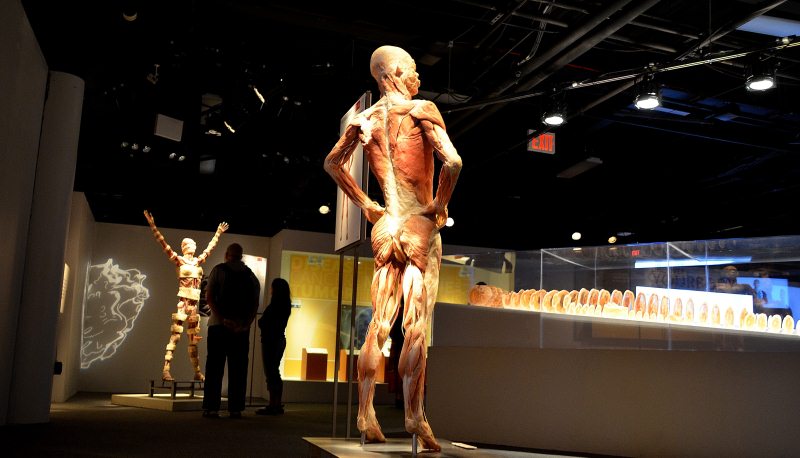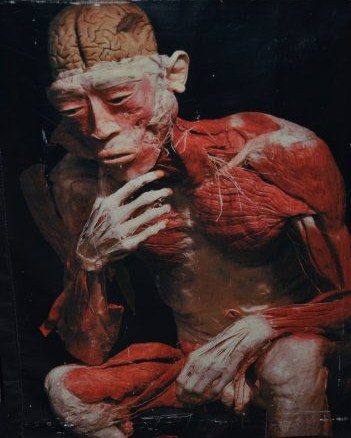Bodies: The Exhibition

|
Bodies: The Exhibition - Please read with Caution
- If Sensitive Please
Don't
 Promotional poster
Bodies: The
Exhibition is a controversial exhibition showcasing preserved human bodies
dissected to display bodily systems. It opened in Tampa, Florida on the 20th of
August 2005. It is similar to, though not affiliated with, the exhibition Body
Worlds (which opened in 1995). The show is operated by Premier Exhibitions which
presents and promotes similar exhibits including "Bodies Revealed", and "Our
Body: The Universe Within" and other entertainment exhibits.
Locations: This show has appeared in Idaho Falls, Miami, Winnipeg, Amsterdam,
Rotterdam, Atlanta, Vienna, Madrid, Buenos Aires, Montreal, Quebec City,
Chicoutimi, Niagara Falls, Bogata, Cordoba, Barcelona, Cincinnati, Santiago de
Chile, Branson, Pragus, Zagreb, Budapest, Lisbon, Atlantic City, Pittsburgh, San
Diego, Las Vegas, Tulsa, Fort Lauderdale, Hartford, San Antonio, Washington
D.C. Omaha, Honolulu, Indianapolis, Phoenix, Sacramento, Tucson, Cleveland,
Seattle, Albuquerque, Columbus, Greensboro, Haifa and
Riga. Exhibit organisation: The exhibit is set up so that you begin at the skeletal
system, more layers (muscular, nervous, circulatory, digestive,
respiratory, urinary and reproductive systems; as well as fetal development and
the treated body) are added in successive rooms. Containing about twenty bodies
in total, each exhibition uses real human bodies that have been preserved
permanently by a process called "polymer preservation" so that they will not
decay. This exhibition is organised by the publicly traded corporation, Premier
Exhibitions Incorporated, which also staged Bodies Revealed first in Seoul,
South Korea and more recently in the US. The company claimed the cadavers were
donated for research by the Chinese government, because all the bodies at the
time of death allegedly had no close next of kin or immediate families to claim
the bodies (see Criticism). Premier claimed the dissections took place at the
Dalian University in Liaoning, China and the resulting specimens were leased to
Premier Exhibitions for the five-year duration of the show. Recent
investigations by the NY Attorney General and 20/20 among other sources have
brought those claims into serious question. Some of the specimens are arranged so that they are performing
activities such as playing poker or conducting an orchestra. Along the way are
other displays showing a human intestine stretched out, the polluted lung of an
adult smoker and all of the arteries and veins without the body itself. The
exhibit of the polluted lung of the smoker also includes a clear standing box in
which visitors can discard their cigarettes and tobacco products after viewing
the display. In the Las Vegas exhibit, there was also a polluted lung of a fetus
on display. One section includes several fetuses in various stages of
development. It is the claim of Premier Exhibitions that all of the fetuses died
due to miscarriages and the disorders which caused each are highlighted on most
of the displays. Visitors are notified by a small sign at the exhibit of the
sensitivity of the fetus gallery just before entrance into the area curtained
off with black curtains. We saw the sign and knew we could skip that room if we
so desired. Preservation of the bodies and organs: The bodies are prevented from decay by a means of a rubberisation
process patented in the 1970's by anatomist Gunther von Hagens. The essence of
the process is the replacement of water and fatty material in the cells of the
body first by acetone and then by plastics, such as silicone rubber, polyester
or epoxy resin. Uncertainty about provenance of the bodies: Questions have been raised about the provenance of the bodies. Although
all the bodies are unclaimed and from the Chinese police, Premier could not
independently verify more about them, such as whether the bodies are of
prisoners that were executed by the Chinese government. Prior to the 2005 US premiere, the Florida Attorney General expressed
the opinion that the State Anatomical Board’s approval should be required. The
Board fought the Tampa exhibit, with its director expressing the opinion that
the exhibit should be shut down. Premiere Exhibitions officials disagreed,
claiming that the Board had jurisdiction only over medical schools and not
museums; the exhibit opened two days ahead of schedule at the Tampa Museum of
Science and Industry. Questions regarding the origins of the bodies continue to be raised. In
2006, reporting from Dalian, China for the New York Times, David Barboza
described "a ghastly new underground mini-industry" with "little government
oversight, an abundance of cheap medical school labor and easy access to
cadavers and organs." Premier representatives say "the bodies were not formally
donated by people who agreed to be displayed." The director of the Anatomical Committee
of the New York Associated Medical Schools (NYAMS) worries that one has "no
documentation of who this is." ABCNews' program 20/20 produced a major report exposing the 'secret
trade in Chinese bodies.' Claiming that bodies are sold on the black market for
$300, the report spawned not only a series of other articles but also a
Congressional inquiry, an investigation by the NY Attorney General, and the
resignation of Premier's CEO Arnie Geller. In 2008, the front page of the exhibition website had a disclaimer
describing the presumed origin of the bodies and fetuses: Disclaimer: -This exhibit displays human remains of Chinese citizens or residents
which were originally received by the Chinese Bureau of Police. The Chinese
Bureau of Police may receive bodies from Chinese prisons. Premier cannot
independently verify that the human remains you are viewing are not those of
persons who were incarcerated in Chinese prisons. -This exhibit displays full body cadavers as well as human body parts,
organs, fetuses and embryos that come from cadavers of Chinese citizens or
residents. With respect to the human parts, organs, fetuses and embryos you are
viewing, Premier relies solely on the representations of its Chinese partners
and cannot independently verify that they do not belong to persons executed
while incarcerated in Chinese prisons. New York Attorney General Andrew Cuomo concluded his investigation of
Premier, finding "The grim reality is that Premier Exhibitions has profited from
displaying the remains of individuals who may have been tortured and executed in
China. Despite repeated denials, we now know that Premier itself cannot
demonstrate the circumstances that led to the death of the individuals. Nor is
Premier able to establish that these people consented to their remains being
used in this manner. Respect for the dead and respect for the public requires
that Premier do more than simply assure us that there is no reason for concern.
This settlement is a start." In June 2007, Elaine Catz quit her job of 11 years as science education
coordinator for the Carnegie Museum of Science in protest over the exhibit,
citing religious objections and questions regarding provenance, including the
issue of reports of organ harvesting from Falun Gong in China. In 2007, a
Washington State bill was introduced to ban exhibits of bodies without clear
documentation of consent, and a similar bill was introduced in January 2008 by
California legislator Fiona Ma. In June 2008 the New York State Senate passed a
bill requiring anyone showing an exhibit that uses real human bodies in museums
across New York to get a permit to show where exactly the bodies came from.
Senator Jim Alesi sponsored the bill. Professional ethicists, human rights activists and religious leaders
have also objected. "Given the (Chinese) government's track record on the
treatment of prisoners, I find this exhibit deeply problematic," said Sharon
Hom, the executive director of the advocacy group Human Rights in China.
Professor Anita Allen, a University of Pennsylvania bioethicist, argued spending
money to "gawk" at human remains should raise serious concerns. Thomas Hibbs,
Baylor University ethicist, compares cadaver displays to pornography in that
they reduce the subject to "the manipulation of body parts stripped of any
larger human significance." Even if consent were to be obtained, Rabbi Danny
Schiff maintains that we should still question what providing "bodies arranged
in showcases for a hungry public" says about a society. Harry Wu, a long-time
human rights activist, terms the practice of obtaining exhibit specimens from
China "immoral" and describes how the Chinese label of 'unclaimed' on bodies may
imply that families were not notified of the death. Why did we go: Bodies was in our New York Pass booklet, we got in 'free' with it. The
exhibition is at the bottom of Fulton Street; we had to walk past it to get to
the Tall Ship Cruise. We were curious. Would we have paid to go in -
No. Criticism: If this is so dreadful on moral, legal, offensive grounds - why has the
exhibition been to so many venues and why has it not been banned. It must make money or it would have closed. We went in fairly late in
the day, there were no more than a couple of dozen people visiting. We got our
picture taken because it was only $5, we got two copies and it proves we were
there. My take - I guess I went in out of curiosity, once in I
went at quite a speed, really not dillying too much as I went. The one piece I
did fine fascinating was the body that had been cut through in thin
slivers. Bears take - Like being back at medical school. I
see it has a place in medical education but not really for the general public
and certainly not for small children. Some of the exhibits were very cleverly
posed. Who is to say people are wrong to visit? I only have a few pictures and have chosen to put them at the end - no cameras are allowed in the exhibition - but they didn't confiscate mobile phones and there are several pictures on the internet.

ALL IN ALL DIDN'T THINK ABOUT THE ISSUE OF PROVENANCE BEFORE I WENT IN WOULDN'T BE INTERESTED TO GO AGAIN |


